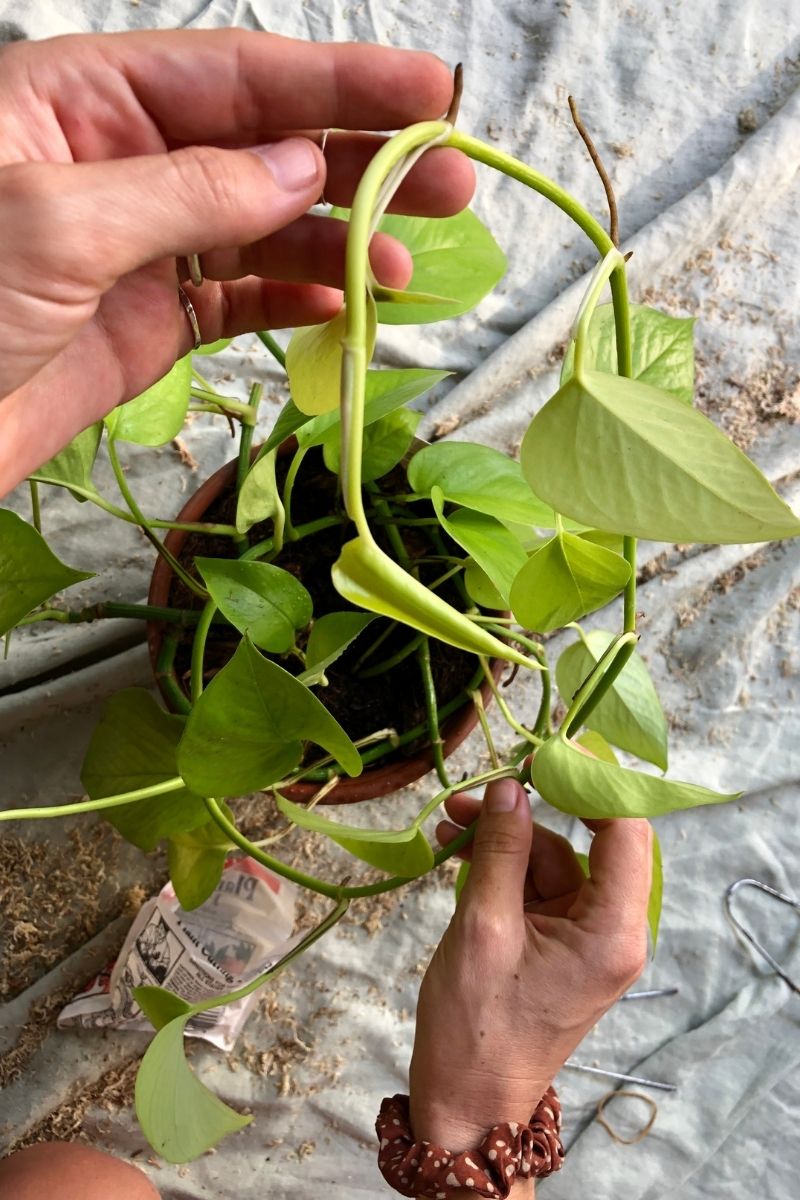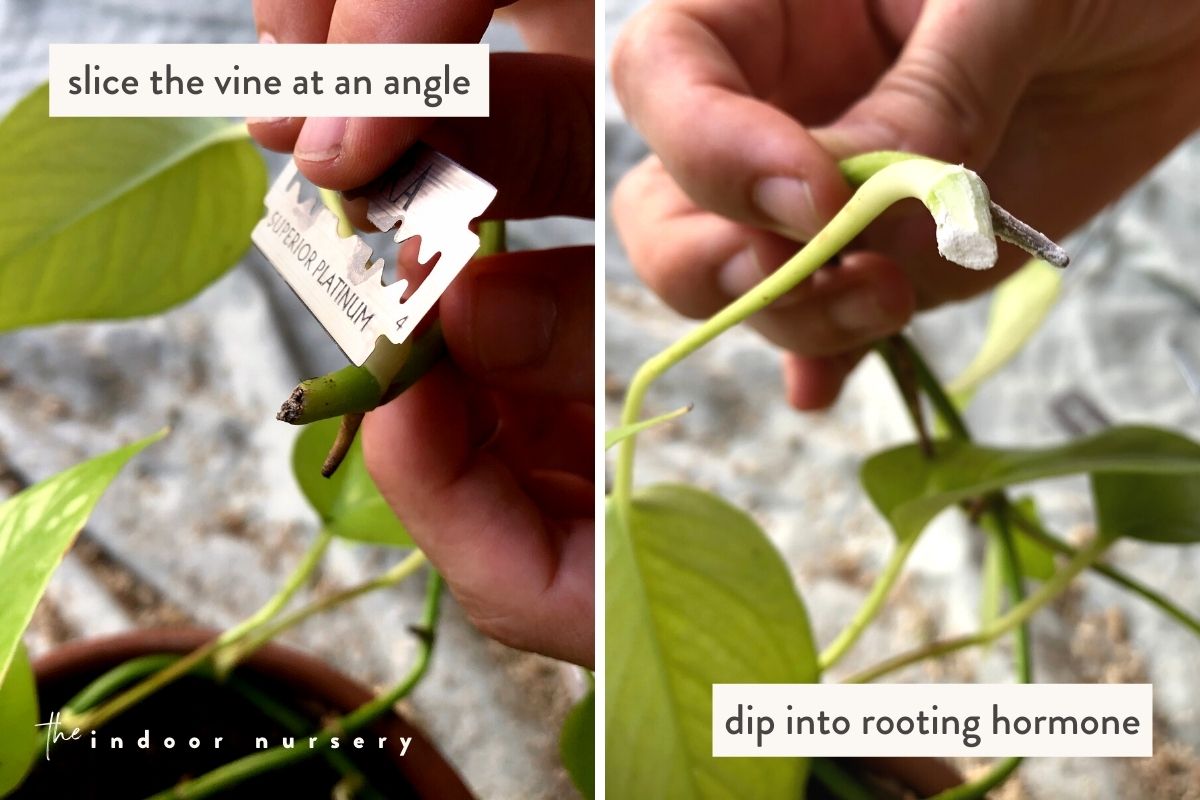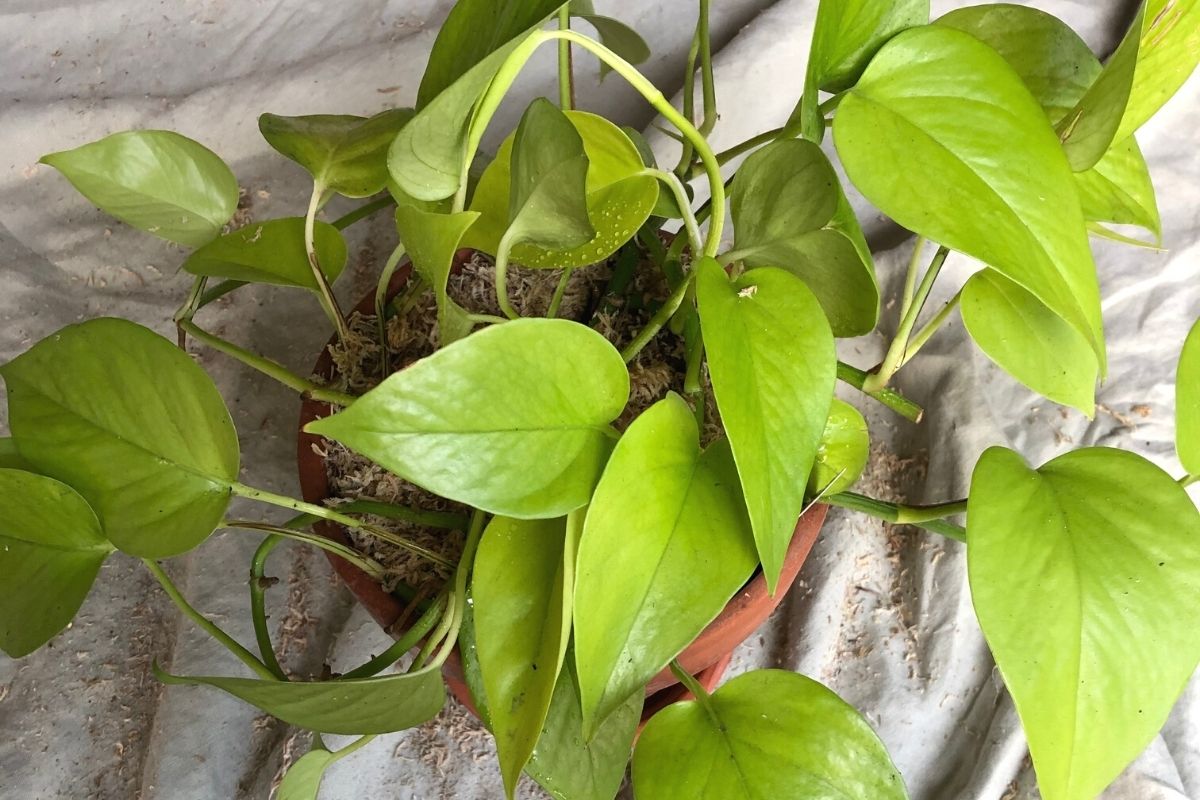The pothos plant, (also called devil’s ivy, silver vine, and money plant… among many other names) is arguably one of the most popular houseplants of all time. It boasts attractive, heart-shaped leaves, beautiful trailing, long vines, and the added benefit of purifying the indoor air.
With so many varieties available, you can put one in every room of your home or office.
And depending on how freely you decorate your space with pothos plants, you might start to notice that they’re not as full or bushy as you were hoping. Instead, the plant is trailing down and around your home or has few leaves at all.
While the pothos is known for their dreamy vine-like appearance, the long stems can leave your pot looking as awkward as a combover.
I know because I had one. (A golden pothos)
So I looked into how to make pothos fuller and realized that all of the tips online were for long-term fullness… not for full.right.now.and.also.long.term.
As impatient as I am, I found a few tricks for making your pothos look fuller right this very minute.
I’ll also go through some tips for healthier, bushier growth in the future.
How to make a trailing pothos fuller right now
I tried a few different things to make my pothos fuller, and these two methods below worked.

1. Wrap the vines around the top
Time to complete: ~5 minutes
Time to fullness: ~5 minutes
Tools needed:
- Plant stakes to hold the vine in place
The pothos plants are natural climbers and winding plants, but to get it to do this in your home, you must provide something for the plant to anchor to and “train” it to climb.
Take the vines and gently wrap them around the top of the pot. If you want your pothos to climb upward, you can use stakes, a bamboo cane, or a moss pole for the aerial roots to attach to.
This pothos staking method will allow the plant to “grow back into itself” and appear fuller without waiting for new growth to occur. It will also learn to climb this way rather than trail downward.
This will avoid wild vines that droop everywhere, and leggy vines that hang down without many leaves.
This is the quickest way to make pothos fuller without waiting for the plant to produce more leaves.
2. Plant cuttings into the soil

Time to complete: ~30 minutes
Time to fullness: ~1-2 months
Tools needed:
Another quick way to get a fuller plant is to cut the longest stems or “tails” from your plant and put them back into the soil. To use plant cuttings to make your pothos fuller,
- Cut a healthy long vine with a clean blade (I like to use a sterile razor blade that I already have for my reusable razor) and cut again between each leaf node.
- Add rooting powder to the cut tips you are planting in order to encourage rooting, and plant these cuttings back into the same pot.
- Cover the new cuttings with sphagnum moss and spray them with filtered water to keep the new cuttings moist. This will allow them to take root and grow.
Instead of a single plant, you will have a few producing a new vine together to make the plant look bigger and fuller.
While it’s exciting that your cuttings will create new growth, be aware that the plant can become root bound if too many plants are rooting in the same pot if the pot is too small.
Be sure your pot is big enough to support new root systems. If you think the plant is too small, consider repotting pothos first before adding new cuttings.
How to make pothos fuller long-term
It’s important to understand how pothos plants work so that you can set up the right conditions so that it grows in fuller and bushier. Because all pothos varieties are vining plants, they use new growth to search for nutrients. While the roots hang back in the soil, the pothos vine explores the jungle floor for water, sunlight, and fresh air.
The aerial roots both absorb nutrients from the air as well as cling onto whatever helps them reach whatever they’re searching for.
By growing in this way, pothos leaves soon spread across jungle floors and up tall trees, giving it a healthy dose of bright indirect light and fresh water.
When we take these vining plants and turn them into a docile houseplant, they can’t help but seek ideal conditions once again. As such, if you’re growing pothos in a room without much light, it will grow toward any bright light that it can find.
Some people take advantage of this and put their pothos plants in a strategic corner of the room so that the houseplants trails across window sills, giving a jungle look to the indoors.
Others prefer a happy little plant with lots of little pothos leaves sticking out from every direction close to the soil.
And since it’s the easiest thing ever to propagate pothos, most of us have the luxury of trying every style of pothos: bushy, vining, in water, and wherever else they’ll grow.
If you’re looking for the bushy kind, then these tips will sort you out.
Prune Your Pothos
While it sounds counter-productive, it is actually really helpful to prune pothos regularly. When you cut the pothos plant, it will shoot out new growth from the node nearest to where you cut it. Giving it a trim forces the plant to grow close to the base, giving it a bushier, fuller look.
The best part?
Now you’ve got yourself a fresh pothos cutting. You can use pothos cuttings for propagation to make even more pothos plants right in the same pot where you started. This can be useful if you are trying to make your pothos look fuller by adding more healthy cuttings to the soil. Once these cuttings root down, they’ll begin shooting out new leaves right from the soil. Propagating pothos is the easiest thing ever, so within a few months, you’ll have the beginning signs of a full and luscious pothos plant.
Fertilize Pothos
Pothos plants need the right nutrients to support vine and leaf growth. Not much is going to happen if your plant is suffering from a nutrient deficiency. Depending on how long your pothos has been in the pot, the soil quality may be lacking.
As plants grow, they eat the nutrients in the soil. If you’re not ready to repot with fresh soil, then your plant may benefit from using indoor plant fertilizer.
While pothos plants are not heavy feeders and don’t require fertilizer for normal growth if you want to encourage faster or fuller growth they will need a little help from a balanced fertilizer system. If your plant has been growing in the same container for years, this method may help you see a fuller pothos plant.
For fertilizing, you can use natural compost or liquid seaweed solution. Apply your fertilizer of choice once or twice a month to boost foliage production and make pothos fuller and healthier. Be sure not to use too much fertilizer as it can burn the plant.
For compost or solid fertilizer, sprinkle it on top of the soil and gently mix it in using a hand trowel. Then you will need to water the plant to activate the fertilizer.
If you’re using liquid fertilizers, mix the necessary amount into the water in a watering can or jug and then pour the solution into the pot, as if you were watering it. Make sure you dilute it by half so as not to burn your plant.
Provide more sunlight
The main reason the pothos develops a leggy look is that it is not getting enough light. Plants grown in low-light conditions will stretch toward any source of light, causing the leaf nodes to spread farther and farther apart from one another. This will cause longer vines but sparse leaves.
The simplest way to make pothos fuller is to move them to a place with sufficient light, such as near a window. Pothos enjoy moderate indirect sunlight, but when grown outdoors they can be grown in shade or partial shade (indirect light). Avoid exposing pothos to direct sunlight as this can be overpowering and can cause the leaves to wilt or curl.
You do not want to cause temperature stress by making the plant too hot. If the pothos plant is placed in the line of light, it will have less distance to travel in order to reach the light, which will make pothos fuller and have a bushy vine.
Water Regularly
Pothos plants don’t necessarily need a lot of water to thrive, unlike other plants. Even so, underwatering your plant certainly won’t help with new foliage. Inadequate water will lead to wilting, leaves turning yellow, and stunted plant growth. Overwatering the plant has its own host of issues, such as root rot or soggy leaves.
To keep a healthy watering schedule for your pothos plant,
- Allow the soil to dry between watering. Test the soil with a touch test or soil probe to check for dryness before applying more water.
- Water your pothos every 1-2 weeks, more often if exposed to bright sunlight.
- Provide adequate drainage in the pot (drainage holes) to allow excess water to drain away easily.
More How To Guides
- How To Get Rid Of Scale On Plants
- DIY Terrarium Table: How To Make A Table With Plants Inside
- How to Use Leca for Plants: Step-by-Step Guide with Pictures
- How To Use Grow Lights For Indoor Plants
- How To Propagate Peperomia Plants 2 Ways
- DIY Propagation Box With Grow Light
- How To Make Pothos Fuller (In 5 Minutes)
- How to Make a Moss Pole for Your Climbing Plants
- How to Make Potting Soil for Indoor Plants, Plus My Secret Ingredient
- How to Propagate a Split-Leaf Philodendron: Easy Step-by-Step Guide




